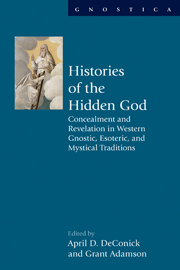 Histories of the Hidden God
Histories of the Hidden God from Part III - Revelations of the Hidden God
Jewish representations of the divinity in late antique synagogue art reflect a simultaneity of revelation and concealment that parallels Targumic interpretations of the human-divine encounter. The use of memra for the active divine principle, or logos, suggests a simultaneous aural immanence and visual hiddenness that synagogue artists expressed through their use of the manus dei. This visual syntax of coincidentia oppositorum uses a boundary or distinction between heavenly and earthly realms to distinguish the aspect of god that remained hidden to the viewer from that aspect of god which was revealed.
The synagogues of both third-century Dura Europos, Syria and sixth-century Palestine Beth Alpha in the Jezereel valley, offer visual representations of god in pars pro toto. This essay discusses the depiction of the hand of god in illustrations of the Akedah, the binding of Isaac, as described in Genesis 22 in light of Targumic interpretations and liturgical poetry. This study employs the “holistic” methodology adapted from Byzantine Christian art history by historian of Jewish art Steven Fine, who proposes interpreting synagogue art in its ritual context. This viewer-centered approach has the advantage of taking into account the polysemic quality of images while attempting to avoid the over-reading and eisegetical shortcomings of earlier scholarship.
To save this book to your Kindle, first ensure [email protected] is added to your Approved Personal Document E-mail List under your Personal Document Settings on the Manage Your Content and Devices page of your Amazon account. Then enter the ‘name’ part of your Kindle email address below. Find out more about saving to your Kindle.
Note you can select to save to either the @free.kindle.com or @kindle.com variations. ‘@free.kindle.com’ emails are free but can only be saved to your device when it is connected to wi-fi. ‘@kindle.com’ emails can be delivered even when you are not connected to wi-fi, but note that service fees apply.
Find out more about the Kindle Personal Document Service.
To save content items to your account, please confirm that you agree to abide by our usage policies. If this is the first time you use this feature, you will be asked to authorise Cambridge Core to connect with your account. Find out more about saving content to Dropbox.
To save content items to your account, please confirm that you agree to abide by our usage policies. If this is the first time you use this feature, you will be asked to authorise Cambridge Core to connect with your account. Find out more about saving content to Google Drive.